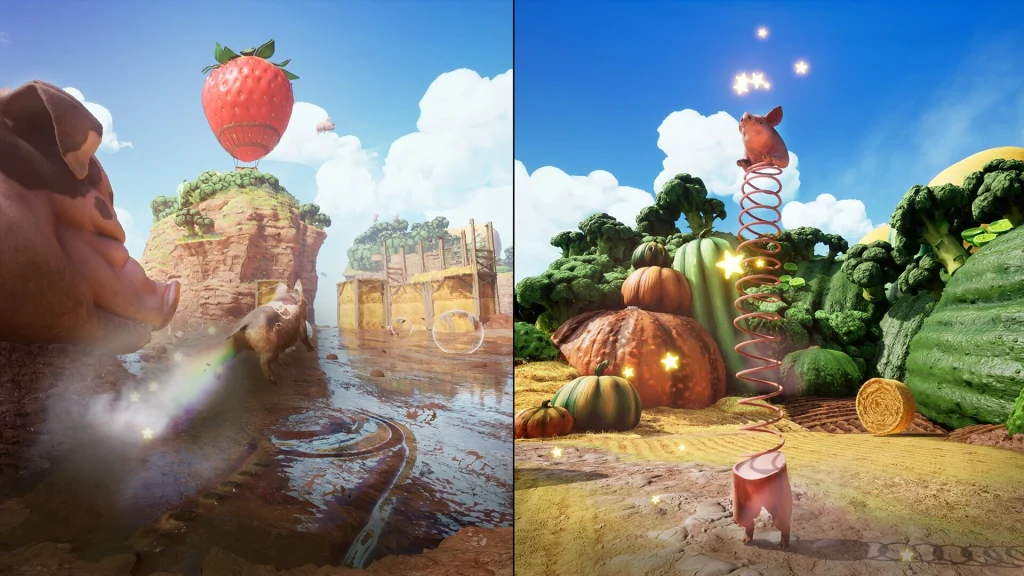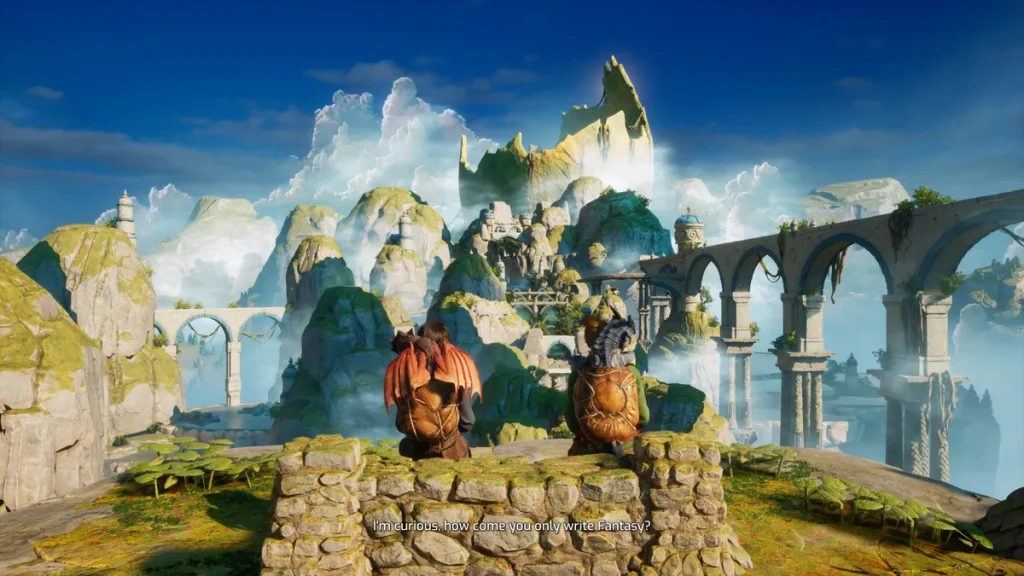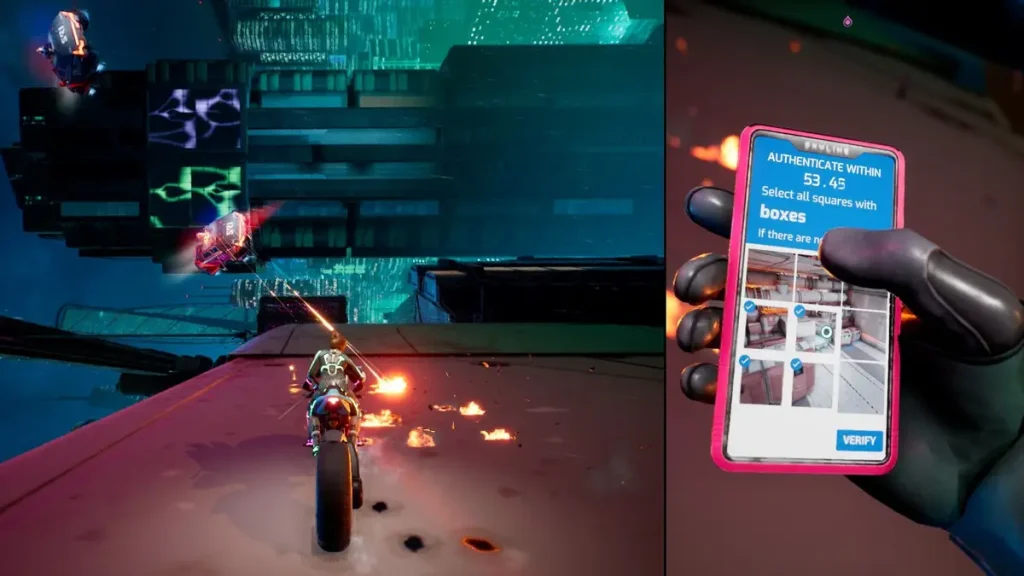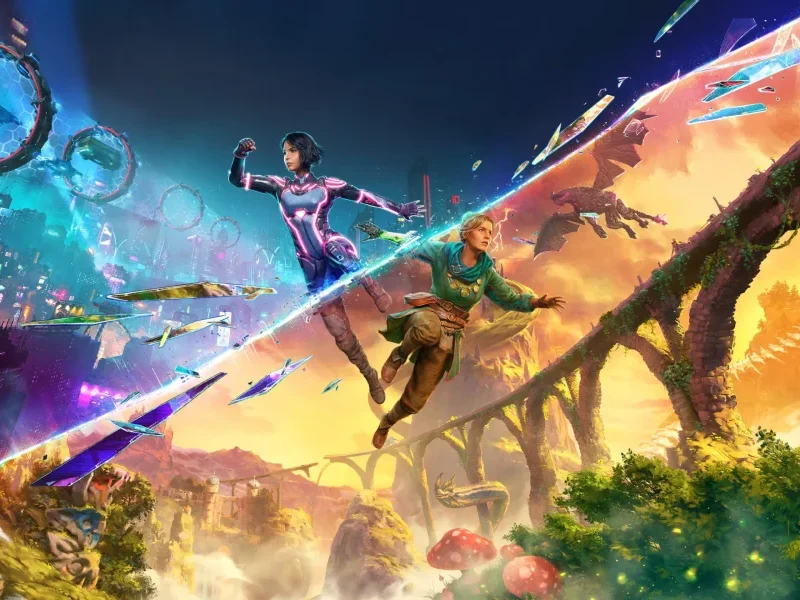Play time: 15 hours
Platform: PlayStation 5
Split Fiction is the follow up game by Hazelight Studios to their Game of the Year-winning It Takes Two in 2021. As is the norm with all their games, it is a strictly split-screen co-op experience following two writers, Mio and Zoe as they navigate their emotional issues through stories that they have crafted in their contrasting styles. I played through this game with my partner over the course of a few sittings.
Point 1: Perfectly Balanced

Split Fiction carries forward one of the strongest points from It Takes Two: the balance in the difficulty of each new gameplay section. For the most part, this is a pretty easy game and the fun comes more from working together with the other person rather than the difficulty of each stage. However, when the game does decide to make certain portions a little challenging (I use this word generously), it’s never a stumper. It also helps to have two people figuring it out. My partner and I have very different tastes and strengths when it comes to gameplay genres, so we alternated figuring out the solution to puzzles, ensuring that we were never stuck in any one area for too long.
For a game like this, I think hitting this balance is the most important thing to keep things moving without getting frustrated. Plus, a game like this is aimed at all audiences, which makes it even more critical to not crank the difficulty up too much. That said, I don’t want it to seem like this game is too easy to be fun for those who play video games regularly. The constant switch up of the mechanics keeps you on your toes at all times. Just as you feel like there’s not much more to do with this mechanic, the game ably either changes it up or pushes back by proving you wrong.

The constant discovery and adjustments make it so that you’re never bored and nothing becomes rote. On the other hand, if there’s a mechanic you might not be a huge fan of, well you know it won’t last too long either. Unless you don’t like to slide. This game LOVES sliding and they’ve found a way to insert that into almost every stage. I know that’s a very specific comment, but it was hard for me to not notice. It became a joke between me and my partner at a certain point where we would try to guess if the next part of the game would have sliding (it usually did).
Point 2: A Feast for the Eyes

One thing that is impossible to miss is the amazing visuals on offer. I’ll flesh out the premise a bit more first though. So Zoe and Mio are put into this machine where basically an evil company will extract all their story ideas from them. In that process, the characters are meant to play through their own stories as if they were the protagonists of their stories. Something goes wrong and Mio and Zoe are stuck having to go through the stories together rather than individually, as it was designed. Since they’re both in the machine together, they also have to cycle through both of their stories. This leads to a constant switch between doing a sci-fi story then a fantasy story then a sci-fi story, and so on and so forth. To punctuate them are also side stories which are shorter adventures based around just one mechanic.
Now that we’ve gotten that out of the way, what all of that means is that every main stage of the game is a brand new world with whole new elements and new mechanics. The characters wear different costumes, their powers are changed, and many times even how you move and the camera perspective are completely different. Whereas It Takes Two contains its creativity within the same locale, this is a true flexing of how far the devs can take their ability to wow you with assets changing constantly. I can’t think of too many games that are bold enough or creative enough to choose to do something like this and also nail it. The only game that comes to mind is the most recent Ratchet & Clank where they would change between worlds.

The worlds have been built with so much attention and love and it really shows on screen. Whether you’re in a medieval kingdom full of trolls or riding futuristic motorcycles through a sci-fi world being chased by parking robots, you will never find yourself being underwhelmed at what is on screen.
Point 3: Leo Point

When you’re trying to cram this many game mechanics and worlds into one game, it is inevitable that you cover ground that other media has also covered. Nothing wrong with that! How you handle it is the main thing. If you do your own thing and sell it in your unique wrapping, that’s what art is all about.
Or you can blatantly reference each and every property you are inspired by… You can guess which path Split Fiction took based on how I wrote that. I’m not saying this is necessarily good or bad. It was just funny to see how shameless some of it is. I’m sure I didn’t even catch everything, but here’s a list of the ones I did notice:
- Hazelight’s own games It Takes Two and A Way Out
- Dark Souls
- Assassin’s Creed
- Dune
- Baldur’s Gate
- Halo
- Sailor Moon
- Metal Gear Solid
- Donkey Kong
- Portal
- Sonic The Hedgehog
And many, many more that I don’t want to exhaustively continue to name, but you get the point! I mostly found these to be fun if you can catch them, but I can see this becoming kind of an overdone joke at some point too. Depends on your perspective. Dunkey’s whole video on this game is basically making fun of the references:
Point 4: Oh My God Please Hire New Writers

I wanted to save this for last because unfortunately it coloured my opinion of the game a lot despite it not being that big a part of the game. Thus, I wanted to make sure I talked up the positives which make up the majority of the game. But I can’t let this slide either.
This has got to be one of the worst-written games I’ve played in a while. The characters are unlikeable for most of the game, the dialogue is grating, and the story has clearly been just quickly reverse-engineered from the idea that they wanted a game that did sci-fi and fantasy. I’m not willing to give the story the credit I’ve seen some people give where they say it’s an allegory for how AI steals artists’ ideas because the execution is way too hamfisted for me to concede that.
Zoe is a country girl that is very peppy and can’t believe people could like living in the city. Being a country girl, she of course loves old fashioned things and fantasy stories. Mio meanwhile is from the big city, is grumpy and thinks up sci-fi dystopian worlds because that’s what tech-loving city kids are like. They are put in a situation where they have to work together to succeed. I wonder where the story could go… Will they start realizing that the other’s interests are maybe also cool? Will they eventually open up and realize they’re more alike than they thought? Surely there will be more to it than that right?
And what about the villain? This guy who is stealing everyone’s ideas. Maybe he has something about him that could be interesting to explore right? Why is he doing this? Oh right, because he’s evil!

If it weren’t disappointing enough to have the most rudimentary story to frame this otherwise brilliant gaming experience, the characters constantly compliment the stories and worlds that have been created. Except that as a player… it’s just the writers and designers constantly patting themselves on the back. It got a little grating for me personally, especially since the writing was not up to snuff at all.
Overall, I think everyone would have a great time playing this game. The creativity on offer is constantly refreshing and never gets old. I had so much fun playing every section. It is disappointing that the story is so lacklustre to bind it together, but it’s not so much a deterrent that I’d tell anyone to not play this.



